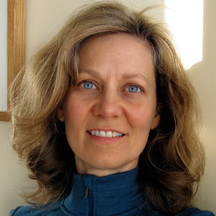
All That Was There and Only
Contributor’s Marginalia: Carol Light on “Bang” by Hannah Sanghee Park
If “Bang” is an indicator of the Ferris wheels and Gravitrons of thought in this poet’s imagination, then I would love to spend a vacation twirling through the carnival of Hannah Sanghee Park’s mind. More minstrel than expostulator, the poet’s tilt-a-whirl logic is dizzying. A pirouetting ballerina uses a spotting technique to keep balance while spinning, and spotting the patterns and formal structures of the poem steadied me through its linguistic dance. Each of the couplets introduces a rhyme at the end of the first line that is immediately and imaginatively bisected in the line that follows.
“Just what they said about the river:
rift and ever.”
I admire this intuitive mind, while my faithful servant follows behind, lugging a dictionary. My inner parser, having tea with the OED, snakes along her river toward the Latin riparia, to the bank beside the channel, to rive, to render and tear, and eventually to the euphemistic boundary between life and death, hence “rift and ever.” The poem both begins and ends in the first two lines. But it continues…
“And nothing was left for the ether
there either.”
The ethereal being, for me, a favorite realm, I applaud the possibilities summoned into being! Latin æther, imported from Greek, shares a root with kindle, burn, shine, and fair weather. The clear sky above the clouds, the cosmological element filling all space beyond the sphere of the moon, divine air breathed by the gods, the luminiferous medium through which the waves of light are propagated, not to mention a solvent possessing anesthetizing properties.
Uncoupling happens in these couplets. The poet’s method is to fabricate a compound history in every second line for the end word of every first line. A sort of associative etymology emerges: mature becomes matter and nature. Scripture becomes scribe and capture. Neither element is half of what it was before. Park’s literary fission liberates energy. If you prefer metaphysics to physics, then perhaps Genesis: the poet is a god separating the heavens from the earth.
“Bang,” recalling Big Bang, flirts with the rhetoric of a creation story that is as religious as it is astronomical. Like the universe, the poem accelerates as it expands. The couplets appear both self-contained and cumulative. I marvel at how the poet builds and balances an elusive narrative, and breaks it in every second line. Overriding all is a sense of heartbreak and loss, of separation, until the empty sky is bleached cleanly clear, evenly, when what is left of the world is what we covet.
Cosmogony, cosmology, cosmatesque. I love to follow the patterns through the lines, but the poem isn’t simply a divine or decorative geometry. Is it a creation story? A love story? A promise broken, line after line? As in any good theory, procreation has its part to play. And Park’s wordplay is a fuse lit at the end. What fireworks lurk inside covet? Cupidity’s hot breath pants under that coverlet, and an invitation to begin again follows the poem’s penultimate conjunction: “Come over et—”
 Carol Light’s first book, Heaven from Steam, will be published in 2013 by Able Muse Press. Her poems have appeared in Narrative Magazine, Poetry Northwest, American Life in Poetry, Literary Bohemian, and elsewhere. She lives with her family in Port Townsend, Washington.
Carol Light’s first book, Heaven from Steam, will be published in 2013 by Able Muse Press. Her poems have appeared in Narrative Magazine, Poetry Northwest, American Life in Poetry, Literary Bohemian, and elsewhere. She lives with her family in Port Townsend, Washington.